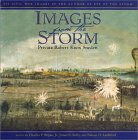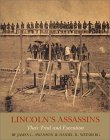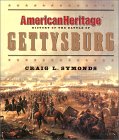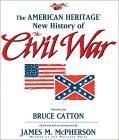
| Books | Books 2 | Books 3 | Books 4 | Books 5 | Books 6 |
| Music | Music 2 | Music 3 |Films | Films 2 | Films 3 | Films 4 | Films 5 | Posters |
April 1865: The Month That Saved America, by Jay Winik
In April 1865 the Civil War appeared to be ending with a whimper rather than a bang. The Army of the Tennessee had been destroyed as an effective force, Sherman was ravaging the Carolinas, and Lee's soldiers were surviving on handfuls of parched corn. In fact, the war did end without a final paroxysm of violence, but there was nothing inevitable about that conclusion. 480 pages. Hardcover. Amazon.com
The Civil War: A Narrative: Fort Sumter to Perryville,
Fredericksburg to Meridian, Red River to Appomattox, by Shelby
Foote
This beautifully written trilogy of books on the American Civil War is
not only a piece of first-rate history, but also a marvelous work of literature.
Shelby Foote brings a skilled novelist's narrative power to this great
epic. Many know Foote for his prominent role as a commentator on Ken Burns's
PBS series about the Civil War. These three books, however, are his legacy.
His southern sympathies are apparent: the first volume opens by introducing
Confederate President Jefferson Davis, rather than Abraham Lincoln. But
they hardly get in the way of the great story Foote tells. 3-volume set.
Hardcover. Amazon.com
Nothing Like It in the World: The Men Who Built
the Transcontinental Railroad 1865-1869, by Stephen E. Ambrose
Abraham Lincoln, who had worked as a riverboat pilot before turning to
politics, knew a thing or two about the problems of transporting goods
and people from place to place. He was also convinced that the United
States would flourish only if its far-flung regions were linked, replacing
sectional loyalties with an overarching sense of national destiny. 431
pages. Hardcover. Amazon.com
Images From the Storm, by Robert Knox
Sneden, and edited by Charles F. Bryan Jr., James C. Kelly, and Nelson
D. Lankford
If
Vietnam was the first television war, the Civil War was the first to use
mass-produced battlefield sketches and drawings as adjuncts to news reports,
filling the pages of publications such as Harper's and Frank
Leslie's Illustrated Weekly. One illustrator, a Union private named
Robert Sneden, had plenty of opportunities to practice his art at close
range, turning out nearly a thousand sketches, maps, and plans of the
great battles in which he participated. 263 pages. Hardcover. Amazon.com
The Civil War Trilogy: Gods and Generals / The
Killer Angels / The Last Full Measure, by Michael Shaara and Jeff
M. Shaara
Author Jeff M. Shaara rounds out the Civil War Trilogy started
by his late father Michael Shaara, whose book The Killer Angels
described the Battle of Gettysburg. While Gods and Generals covered
action prior to Gettysburg, The Last Full Measure picks up with
Confederate General Robert E. Lee's retreat from Pennsylvania and continues
through the end of the war. The younger Shaara focuses on the characters
of Lee and Union commander Joshua Lawrence Chamberlain, both of whom play
prominent roles in the earlier books. He also introduces a new one: Ulysses
S. Grant, the Union general who would finally defeat the South--something
no soldier before him could manage. The Last Full Measure is often
exciting and poignant, and fans of The Killer Angels and Gods
and Generals won't be disappointed. A nicely boxed edition of this
classic historical fiction. Boxed set. Paperback. Amazon.com
Lincolnís Assasins: Their Trial and Execution,
by James L. Swanson and Daniel R. Weinberg
On April 14, 1865, the president of the United States went to the theater.
Five days earlier Lee had surrendered to Grant. The Civil War was over
and the North held a jubilee. On that night John Wilkes Booth assassinated
Lincoln, and soon the murderer was hunted down and killed by federal troops.
But the story of the Lincoln assassination does not end with his state
funeral and the death of his killer. Lincoln's Assassins: Their Trial
and Execution resurrects these events by presenting an unprecedented visual
record of more than 200 contemporary photographs, documents, prints, woodcuts,
newspapers, pamphlets, books, and artifacts, many hitherto unpublished.
Highlights include original albumen prints, cartes de visite, stereo cards,
reward posters for the conspirators, the trial transcripts, the manuscript
order for execution, and the seminal series of photographs by famed Civil
War photographer Alexander Gardner of the conspirators in prison and during
their execution. 144 pages. Hardcover. Amazon.com
American Heritage History of the Battle of Gettysburg
, by Craig L. Symonds
This lavishly illustrated chronicle of the battle of Gettysburg in July
1863 begins with a letter from Brigadier General John D. Imboden of the
Confederate Army, who was in charge of a wagon train of wounded and dying
soldiers. "During this one night I realized more of the horrors of war
than I had in all the two preceding years," he wrote. His letter vividly
sets the tone of the book, which describes the three-day battle, the deadliest
in American history. Symonds, author of six previous Civil War books,
explains the military strategy of both sides, from Chancellorsville, Virginia,
in May, where the sequence of events led to the battle, to General Robert
E. Lee's escape across the Potomac River. Symonds draws on letters, diaries,
and memoirs to complement his incisive text. 320 pages. Hardcover. Amazon.com
The American Heritage New History of the Civil
War, by Bruce Catton
Ask Civil War diehards when they first fell in love with the War Between
the States and there's a good chance you'll hear about one of the early
editions of this book, which was originally published on the war's centennial.
Thoroughly updated by the remarkable James M. McPherson to take advantage
of the latest scholarship, this classic retains all of the wonderful features
Bruce Catton originally included. And then there are the pictures--they
are some of the most striking battlefield visuals available. The American
Heritage New History of the Civil War makes a great gift for young
people interested (or potentially interested) in history, or good reading
for folks who want an overview of how the North and South fought across
five Aprils. 630 pages. Hardcover. Amazon.com
The Longest Night: A Military History of the Civil
War, by David Eicher, James M. McPherson, and Lee Vande Visse
The American Civil War was such a seminal conflict that it seems to compel
historians to analyze its causes, course, and effects in terms of broad
themes; thus, it is all too easy to forget that the war was fought day
to day, even moment to moment, and that the outcome was the result of
countless small decisions as well as larger strategic choices. Eicher
is an astronomer and Civil War historian. He has written a masterful single-volume
military history that covers virtually every essential aspect of the conflict.
Those unfamiliar with military terminology and basic tactical and strategic
theories will probably struggle with some portions of the text. However,
Civil War buffs and military history scholars will find Eicher's superb
analyses and original insights into oft-neglected theaters of operations
extremely valuable. An important work that will be an essential component
of Civil War collections. 990 pages. Hardcover. Amazon.com
An Honorable Defeat: The Last Days of the Confederate
Government, by William C. Davis
In the final days of the Civil War, when defeat loomed for the South,
Confederate Secretary of War John C. Breckenridge warned, "This has been
a magnificent epic. In God's name, let it not terminate in a farce." To
be sure, there were plenty of farcical moments -- even pathetic ones--as
the Confederate government breathed its last. President Jefferson Davis
fled capture but was ultimately apprehended in disguise; he was wearing
his wife's clothing. Union soldiers detected his "distinctly unfeminine
cavalry boots and spurs" and arrested him. Then there was "the last official
act of the Confederate government itself" -- Breckinridge giving a commission
in jest to a soldier who had already surrendered because the man wanted
to outrank one of his fellows. 512 pages. Hardcover. Amazon.com









